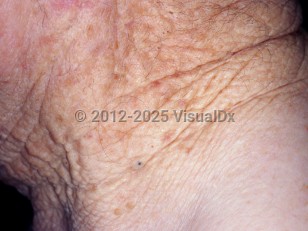Solar elastosis
Alerts and Notices
Important News & Links
Synopsis

Solar elastosis (also known as actinic elastosis) is a common manifestation of chronic sun exposure and is a form of dermatoheliosis, or photoaging. It specifically refers to the histologic observation of massive deposits of amorphous, yellow, elastin-like (elastotic) material in the upper dermis that does not form functional elastic fibers.
Clinically, solar elastosis presents as yellow, thickened, coarsely wrinkled skin in a photodistribution. Depending on the degree and amount of cumulative sun exposure, the findings can start to be observed in the third decade with gradual progression over the years. Individuals with lighter skin phototypes and a significant history of sun exposure are the highest risk group.
There are many clinical variants of solar elastosis, including cutis rhomboidalis nuchae, Favre-Racouchot syndrome, colloid milium, actinic comedonal plaque, actinic granuloma, elastotic nodules of the ear, arcus senilis, striated beaded lines, keratoelastoidosis marginalis, diffuse elastoma, and elastotic bands.
Solar elastosis is often associated with other signs of photodamage (such as lentigines, poikiloderma, and facial telangiectasias), actinic keratoses, and skin cancers.
Clinically, solar elastosis presents as yellow, thickened, coarsely wrinkled skin in a photodistribution. Depending on the degree and amount of cumulative sun exposure, the findings can start to be observed in the third decade with gradual progression over the years. Individuals with lighter skin phototypes and a significant history of sun exposure are the highest risk group.
There are many clinical variants of solar elastosis, including cutis rhomboidalis nuchae, Favre-Racouchot syndrome, colloid milium, actinic comedonal plaque, actinic granuloma, elastotic nodules of the ear, arcus senilis, striated beaded lines, keratoelastoidosis marginalis, diffuse elastoma, and elastotic bands.
Solar elastosis is often associated with other signs of photodamage (such as lentigines, poikiloderma, and facial telangiectasias), actinic keratoses, and skin cancers.
Codes
ICD10CM:
L57.8 – Other skin changes due to chronic exposure to nonionizing radiation
SNOMEDCT:
43982006 – Solar degeneration
L57.8 – Other skin changes due to chronic exposure to nonionizing radiation
SNOMEDCT:
43982006 – Solar degeneration
Look For
Subscription Required
Diagnostic Pearls
Subscription Required
Differential Diagnosis & Pitfalls

To perform a comparison, select diagnoses from the classic differential
Subscription Required
Best Tests
Subscription Required
Management Pearls
Subscription Required
Therapy
Subscription Required
References
Subscription Required
Last Reviewed:01/17/2021
Last Updated:01/24/2021
Last Updated:01/24/2021
Solar elastosis

